An Armenian Saga Sireli Göta… (In memory of Göta Fjäll Erzinkian)
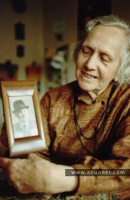 …It was November 1996. I was in Uppsala, the well-known Swedish university town. My goal was to explore Armenian-Swedish relations. On my second day, I tried to find the tomb of Souren Erzinkian, a Soviet politician and journalist who was the first Armenian inhabitant of Uppsala. It was the only remnant I expected to find of a person who had died more than thirty years ago, for I knew that he had no heirs in Sweden.
…It was November 1996. I was in Uppsala, the well-known Swedish university town. My goal was to explore Armenian-Swedish relations. On my second day, I tried to find the tomb of Souren Erzinkian, a Soviet politician and journalist who was the first Armenian inhabitant of Uppsala. It was the only remnant I expected to find of a person who had died more than thirty years ago, for I knew that he had no heirs in Sweden.
But only a month later an Armenian family presented me a book whose cover showed one of Martiros Sarian’s landscapes. The book, titled Fairy tales from the Caucasus, was written by Göta M. Fjäll. “This book was published by an old Swedish woman from Finland, who had married an Armenian,” my friends told me. “And she still lives in Uppsala.” In the preface of the book, there was a note: “These tales were been written down by my late husband Souren Erzinkian Loreli, an Armenian from the Caucasus. He bequeathed me the right of publication of his literary heritage, and these tales are part of it. Göta Fjäll Erzinkian.”

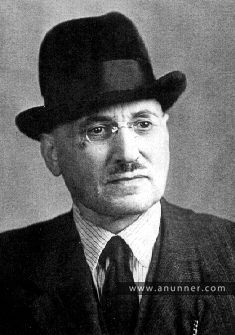
I was so surprised. It meant that in this beautiful corner of highly civilized Sweden, at the end of the twentieth century, the wife of a man of a long-gone epoch was still alive. One December day, I had a chance to visit Göta Magdalena Fjäll-Erzinkian, a white-haired, bent, but cheerful woman, who was over eighty years old. On the door of that lonely Finnish-Swedish woman was written an Armenian surname–Erzinkian.
“Bari galoust (You are welcome),” she said to me in Armenian.
Her one-room apartment was a surprise to me: it was far from average Swedish standards, with its small size and modest furnishings. So, Souren Erzinkian spent his last years in this tiny room. On the floor, there were different oriental carpets; on the walls, many photos and posters (really not typical for Sweden). They all were souvenirs of Göta’s students, whom she taught Swedish for many years without being paid.
I was interested in every little detail, and Göta (pronounced Yota), who spoke English and French fluently, was patiently trying to satisfy my curiosity. She was recollecting the early memories of her husband about his parents and himself. Stories from over one hundred years ago...

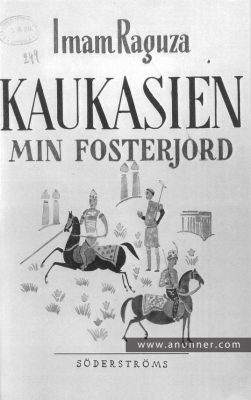
A poor boy from historical Haghbat village of the Armenian Lori region went to Tiflis (Tbilisi) for study. He had nobody there, and was homeless for a while. The chief priest of an Armenian seminary noticed his beautiful singing, and became his patron. Later the priest married his young daughter to that poor boy. These were Souren Erzinkian’s parents. After graduating from Armenian school in Tiflis, at the beginning of our century, in 1901 or 1902, Souren left for Paris to study at the Sorbonne. Later, he studied law at Geneva University. In Geneva, Souren was surrounded by students, full of democratic ideas. At first, he joined the Hnchak Armenian political party, but he soon became a communist. In 1902, Erzinkian got acquainted with Lenin in Geneva. Erzinkian became the founder and chairman of the “Caucasus” international union or association in Geneva in 1905. After returning to Tiflis, Erzinkian began to actively participate in literary and social circles, writing a number of books and disseminating Bolshevik literature, for which he was imprisoned during the Russian Civil War. From 1921 to 1926, he edited Armenian and Russian periodicals (Martakoch, Karmir astgh, Zarya Vostoka), and then, from 1928 to 1929, served as the commercial representative of the Soviet Union in Finland. His wife, from whom he soon divorced, and their two children, were living with him in Helsinki.
In 1929, a member of Yagoda’s Cheka (Soviet secret police) suggested that Erzinkian conduct some machinations in Soviet petroleum selling, promising in return a certain amount of profit to him. Soviet Chekists pressured him to cover their deceptions, which were wasting the state budget. Erzinkian rejected collaboration, and therefore became a dangerous person for them. Actually, his honesty was a disturbing factor for many people. Stalin’s totalitarian system grew up gradually around him, and honest communists became undesirable. Erzinkian decided to return to his native village of Hagbat, and work in a collective farm. But the Kremlin forbade him to leave Russia. In the spring of 1930, Erzinkian returned to Finland and unexpectedly decided never return to the Soviet Union. Later he wrote: “That kind of emigration was a deep pain and torture to me, yet that was the only way not to become a martyr.”
“He had known a lot of things,” related Göta. “He was a very undesirable person for the Soviet government. And his whole life in Scandinavia was half-legal, if not clandestine. Souren was afraid of everything. He seemed to see Soviet spies everywhere. He was sure that Stalin had diverged from the true communist way. Nevertheless, Souren remained faithful to Lenin’s party and ideology until his death, and loved Soviet Armenia with special warmth and immense filial love.”
In Helsinki, Erzinkian continued his literary work. Publishers were interested in printing his anti-Soviet books, which revealed the true face of the communist system. Erzinkian wrote in Russian or French, and afterwards they were translated into Finnish or Swedish. He published his first book, Kamo: Lenin’s friend and Stalin’s Friend and Countryman (1934, Helsinki, in Finnish and Swedish) under the pseudonym H. Lorelli, taken from the name of his original Lori land. The biography of Kamo, the adventurous Armenian revolutionary, was written as fiction. Lorelli’s other books include Stalin’s Life (1938, Paris, in French; 1944, Helsinki, in Finnish), and The Caucasus is My Fatherland (1944, in Swedish). The Story of a Soviet Cow (1943, in Finnish) is a satirical work about “the fall of kulaks” (rich peasants) in Soviet times. During those years, any peasant who has more than one cow used to be exiled to Siberia as a kulak. The hero of the tale is a cow, who gives birth to a calf. She realizes then that her lovely owner will be exiled soon, so the faithful animal has no other choice but... to die from sorrow.
Göta continued her story.
It was during the Second World War. I studied literature, sociology and languages at Helsinki University. After my father’s death, I had to quit studying and earn a living by myself. I started to work in a post office. After some time passed, a foreigner began to visit our post office and send parcels to Switzerland. I met him in the street too. As soon as we got acquainted, I learned he was an Armenian refugee from the Soviet Union. He was sending some of his documents to his friend in Geneva, fearing that the Soviet army would invade Finland and the communists will obtain those important papers.
He suggested that I marry him. You know, I was too idealistic; I did not have great expectations from life. After reaching adulthood, I knew that I had to devote my life to an old man, and surround him with attention and care. I accepted, even though he had neither job, nor money, and was thirty-two years older than me.

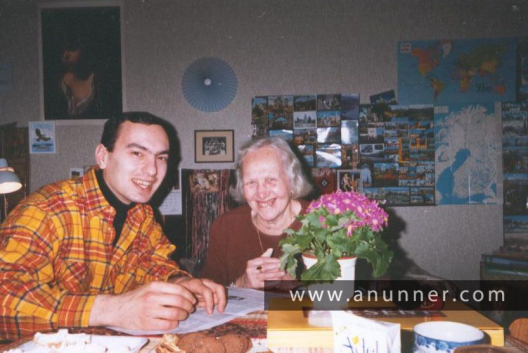
In 1944 Souren Erzinkian, afraid of the possibility of a Soviet invasion to Finland, went to the north of the country and crossed the Finnish-Swedish border. Göta soon joined him, and they married in Sweden. The couple settled in Uppsala, for it was forbidden to foreigners to live in big cities at the time. Their life was a modest one, if not poor. In the beginning, only Göta had a job, but she became sick and lost her ability to work. The Erzinkians were constrained to live on a small state grant. Sometimes Souren even had no paper for writing. However, he managed to earn some money. He published two books in 1945 in Sweden: Caucasian Folk Tales, and Stalin and the Soviet Union. All his books were published under the pseudonym of Imam Raguza, except for the last one, which was signed Arsen Asatyani. Erzinkian was interested in the old historical relations of Sweden with Armenians. He saved from destruction an important part of the files of the eminent Armenian philologist Norayr Biuzandatsi (Néandre de Bycance) that were kept in Göteborg in a very poor state. Erzinkian wrote articles about Swedish literature and other matters in the Armenian pro-Soviet periodicals of Europe, US, and the Near East. He was very concerned about his archives. He presented a part of them to the Uppsala University library. However, the library catalogues revealed his real name next to the pseudonym Imam Raguza, which made him very upset. Erzinkian did not want his identity known during his lifetime even in Uppsala. He took back his archives and sent them to Norway, to the Oslo University library.
“Somewhere in his papers he wrote something like this. ‘I hope after my death the world will be changed, and someone from my country can come and investigate my archives.’ But he told me: ‘Promise me, Göta, not to tell any Armenian where my papers are.’” And though Souren was an atheist, he wanted to be buried by a priest.”
I suggested Göta to title the book Fairy Tales from Caucasus. She had been awarded a prize in 1994 as a philanthropic teacher, and published the book with the prize money. The volume included twenty-four tales of various Caucasian nations (three of them are Armenian). Göta transferred the profits from the book to the International Fund of Homeless Children...

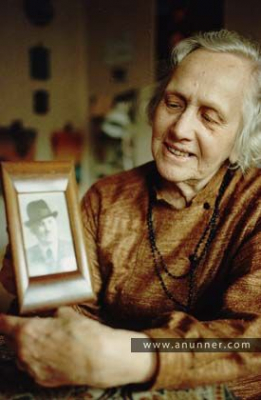
Göta performed as herself in a Swedish documentary, Her Armenian Prince, which depicted Souren Erzinkian and his widow. The authors of the film revealed from Finnish archives some secret details about this mysterious Lorelli, which Göta had never known. Those details, regarding Lorelli’s personal life, made Göta sad, though she always tried to be magnanimous and not show her unhappiness about them.
Erzinkian’s rich and valuable archive is kept at the Oslo University library. Perhaps its most valuable piece is Lorelli’s diary, written in prison on toilet paper, which he wrote at the beginning of the last century in Russian, but with Armenian letters. It is a unique document, whose contents promise to be extremely interesting.
During my stay in Uppsala I visited Göta several times in order to hear her interesting stories, and the Armenian expressions and songs that she remembered. And the joyous and kind widow was always so happy to welcome people from her husband’s homeland, people to whom she could now tell everything about her legendary husband and his stormy times.
Now, in 2006, those two immigrants are together in the central cemetery of pretty Uppsala, after some forty years of separation. And as we Armenians say, let the Swedish earth lie easily on them.
• ՀՈԴՎԱԾՆԵՐԸ ՄԱՍՆԱԿԻ ԿԱՄ ԱՄԲՈՂՋՈՒԹՅԱՄԲ ԱՐՏԱՏՊԵԼՈՒ ԿԱՄ ՕԳՏԱԳՈՐԾԵԼՈՒ ԴԵՊՔՈՒՄ ՀՂՈՒՄԸ www.anunner.com ԿԱՅՔԻՆ ՊԱՐՏԱԴԻՐ Է :
• ԵԹԵ ԴՈՒՔ ՈՒՆԵՔ ՍՈՒՅՆ ՀՈԴՎԱԾԸ ԼՐԱՑՆՈՂ ՀԱՎԱՍՏԻ ՏԵՂԵԿՈՒԹՅՈՒՆՆԵՐ ԵՎ
ԼՈՒՍԱՆԿԱՐՆԵՐ,ԽՆԴՐՈՒՄ ԵՆՔ ՈՒՂԱՐԿԵԼ ԴՐԱՆՔ info@anunner.com ԷԼ. ՓՈՍՏԻՆ:
• ԵԹԵ ՆԿԱՏԵԼ ԵՔ ՎՐԻՊԱԿ ԿԱՄ ԱՆՀԱՄԱՊԱՏԱՍԽԱՆՈՒԹՅՈՒՆ, ԽՆԴՐՈՒՄ ԵՆՔ ՏԵՂԵԿԱՑՆԵԼ ՄԵԶ` info@anunner.com:
| Կիսվել : |
 18:13
18:13 Սեպտեմբերի 23-ին Երևանի «Գևորգյան» ցուցասրահում տեղի ունեցավ հայազգի նկարիչ Օնիկ Սահակյանի անհատական ցուցահանդեսը: Սա այն դեպքն է, որի մասին անվերապահորեն կարելի է ասել՝ «անցավ աննախադեպ հաջողությամբ»: Ցուցադրությունը տևեց 15 օր, որի ընթացքում օրական 200-ից ավելի այցելու էր գալիս: Բերված 16 աշխատանքից յոթը վաճառվեցին (14-ը հատուկ նկարվել էր Երևան բերելու համար): Այստեղ մեծ դեր ուներ ոչ միայն պրոֆեսիոնալ գովազդը, այլև այն հանգամանքը, որ Սահակյանը եղել է Սալվադոր Դալիի մտերիմ բարեկամը և օգնականը: ...
Սեպտեմբերի 23-ին Երևանի «Գևորգյան» ցուցասրահում տեղի ունեցավ հայազգի նկարիչ Օնիկ Սահակյանի անհատական ցուցահանդեսը: Սա այն դեպքն է, որի մասին անվերապահորեն կարելի է ասել՝ «անցավ աննախադեպ հաջողությամբ»: Ցուցադրությունը տևեց 15 օր, որի ընթացքում օրական 200-ից ավելի այցելու էր գալիս: Բերված 16 աշխատանքից յոթը վաճառվեցին (14-ը հատուկ նկարվել էր Երևան բերելու համար): Այստեղ մեծ դեր ուներ ոչ միայն պրոֆեսիոնալ գովազդը, այլև այն հանգամանքը, որ Սահակյանը եղել է Սալվադոր Դալիի մտերիմ բարեկամը և օգնականը: ...
 18:10
18:10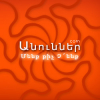 1900 թվականին Ֆլորենցիայի եւ Փարիզի երկու հրատարակչություն լույս են ընծայել ֆրանսերեն մի գիրք՝ «Տեսություն (սոցիալական հետազոտություն)» («Considռrations (Etudes sociales)») վերնագրով, որի հեղինակը հանդես էր եկել Արմենա ծածկանվամբ: Գիրքը, որ վերաբերում էր հայկական հարցին և այդ խնդրի շուրջ եվրոպական դիվանագիտության դիրքորոշմանը, լայն արձագանք է ունեցել եվրոպացի մասնագետների շրջանում: Հեղինակին անվանել են «վեհանձն և բորբոքյալ հոգի», «հանրագիտակ»: Ֆրանսիացի քաղաքական գործիչ Ժան Ժորեսն այդ գիրքը համա...
1900 թվականին Ֆլորենցիայի եւ Փարիզի երկու հրատարակչություն լույս են ընծայել ֆրանսերեն մի գիրք՝ «Տեսություն (սոցիալական հետազոտություն)» («Considռrations (Etudes sociales)») վերնագրով, որի հեղինակը հանդես էր եկել Արմենա ծածկանվամբ: Գիրքը, որ վերաբերում էր հայկական հարցին և այդ խնդրի շուրջ եվրոպական դիվանագիտության դիրքորոշմանը, լայն արձագանք է ունեցել եվրոպացի մասնագետների շրջանում: Հեղինակին անվանել են «վեհանձն և բորբոքյալ հոգի», «հանրագիտակ»: Ֆրանսիացի քաղաքական գործիչ Ժան Ժորեսն այդ գիրքը համա...
 18:07
18:07 Երևանյան դերասանների ընտանիքում Մնջախաղի պետական թատրոնի դերասանուհի Ռուզան Հակոբյանը էականորեն տարբերվում է իր գործընկերուհիներից։ Ոչ միայն իր տարաշխարհիկ, ոչ ստանդարտ արտաքինով։ Թվում է, թե մեր դերասանուհիներից ուրիշ ոչ մեկի խաղն այնքան ենթարկված չէ պլաստիկային, որքան նրանը։ Թվում է, թե իր մարմնի շարժումներով և արտահայտիչ դիմախաղով նա ի զորու է մարմնավորել ամեն մի երևույթ։ Պլաստիկայի լեզվով կերպարի ոչ միայն արտաքինը, այլև ներքինը պատկերելու նրա ձիրքն անուրանալի է։ Երբ որ Ռուզան Հակոբյանը մարմն...
Երևանյան դերասանների ընտանիքում Մնջախաղի պետական թատրոնի դերասանուհի Ռուզան Հակոբյանը էականորեն տարբերվում է իր գործընկերուհիներից։ Ոչ միայն իր տարաշխարհիկ, ոչ ստանդարտ արտաքինով։ Թվում է, թե մեր դերասանուհիներից ուրիշ ոչ մեկի խաղն այնքան ենթարկված չէ պլաստիկային, որքան նրանը։ Թվում է, թե իր մարմնի շարժումներով և արտահայտիչ դիմախաղով նա ի զորու է մարմնավորել ամեն մի երևույթ։ Պլաստիկայի լեզվով կերպարի ոչ միայն արտաքինը, այլև ներքինը պատկերելու նրա ձիրքն անուրանալի է։ Երբ որ Ռուզան Հակոբյանը մարմն...
 17:57
17:57 Համաշխարհային թատրոնի պատմությունն ուսումնասիրելիս նկատելի է մի ուշագրավ իրողություն. 19-րդ դարի վերջին, 20-րդ դարի սկզբին մի շարք հայորդիների վիճակվել է դառնալ այս կամ այն ժողովրդի թատերական գործի ռահվիրա։ Թուրքական պրոֆեսիոնալ թատրոնի հիմնադիրներ դարձան Հակոբ Վարդովյանը և Մարտիրոս Մնակյանը, Իրանում եվրոպական տիպի առաջին ներկայացումը բեմադրեց Արմեն Օհանյանը, վրացական նոր թատրոնի հիմնադիրներից է Միխայիլ Թումանովը, ռուսական էստրադային թատրոնի հիմքը դրեց Նիկիտա Բալիևը, Մոսկվայի հրեական թատրոնինը՝ ...
Համաշխարհային թատրոնի պատմությունն ուսումնասիրելիս նկատելի է մի ուշագրավ իրողություն. 19-րդ դարի վերջին, 20-րդ դարի սկզբին մի շարք հայորդիների վիճակվել է դառնալ այս կամ այն ժողովրդի թատերական գործի ռահվիրա։ Թուրքական պրոֆեսիոնալ թատրոնի հիմնադիրներ դարձան Հակոբ Վարդովյանը և Մարտիրոս Մնակյանը, Իրանում եվրոպական տիպի առաջին ներկայացումը բեմադրեց Արմեն Օհանյանը, վրացական նոր թատրոնի հիմնադիրներից է Միխայիլ Թումանովը, ռուսական էստրադային թատրոնի հիմքը դրեց Նիկիտա Բալիևը, Մոսկվայի հրեական թատրոնինը՝ ...
 17:49
17:49 2007թ-ին Լոնդոնում լույս տեսավ Ֆրանսիայում, Անգլիայում և Ավստրալիայում աշխատած բալետի պարուհի Թամարա Չինարովա Ֆինչի «Պարելով դեպի անհայտը. իմ կյանքը «Բալե Ռյուսում» և նրանից հետո» հուշագիրքը։ Այս պարուհին չի հասել համաշխարհային ճանաչման, սակայն ապրել է հարուստ և հետաքրքրական կյանքով։ Իննսունամյակի շեմին գտնվող նախկին արվեստագիտուհու այդ չափազանց հետաքրքրական հատորն ընթերցելուց հետո նամակով կապվեցինք այսօր Իսպանիայում դստեր հետ ապրող Չինարովայի հետ. վերջինս հաճույքով թույլատրեց թարգմանել իր գր...
2007թ-ին Լոնդոնում լույս տեսավ Ֆրանսիայում, Անգլիայում և Ավստրալիայում աշխատած բալետի պարուհի Թամարա Չինարովա Ֆինչի «Պարելով դեպի անհայտը. իմ կյանքը «Բալե Ռյուսում» և նրանից հետո» հուշագիրքը։ Այս պարուհին չի հասել համաշխարհային ճանաչման, սակայն ապրել է հարուստ և հետաքրքրական կյանքով։ Իննսունամյակի շեմին գտնվող նախկին արվեստագիտուհու այդ չափազանց հետաքրքրական հատորն ընթերցելուց հետո նամակով կապվեցինք այսօր Իսպանիայում դստեր հետ ապրող Չինարովայի հետ. վերջինս հաճույքով թույլատրեց թարգմանել իր գր...












 Arian AMU
Arian AMU
